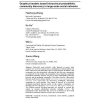Free Online Productivity Tools
i2Speak
i2Symbol
i2OCR
iTex2Img
iWeb2Print
iWeb2Shot
i2Type
iPdf2Split
iPdf2Merge
i2Bopomofo
i2Arabic
i2Style
i2Image
i2PDF
iLatex2Rtf
Sci2ools
IJDMMM
2010
2010
Graphical models based hierarchical probabilistic community discovery in large-scale social networks
: Real-world social networks, while disparate in nature, often comprise of a set of loose clusters (a.k.a. communities), in which members are better connected to each other than to the rest of the network. In addition, such communities are often hierarchical, reflecting the fact that some communities are composed of a few smaller, sub-communities. Discovering the complicated hierarchical community structure can gain us deeper understanding about the networks and the pertaining communities. This paper describes a hierarchical Bayesian model based scheme namely hierarchical social network-pachinko allocation model (HSN-PAM), for discovering probabilistic, hierarchical communities in social networks. This scheme is powered by a previously developed hierarchical Bayesian model. In this scheme, communities are classified into two categories: super-communities and regular-communities. Two different network encoding approaches are explored to evaluate this scheme on research collaborative net...
Related Content
| Added | 27 Jan 2011 |
| Updated | 27 Jan 2011 |
| Type | Journal |
| Year | 2010 |
| Where | IJDMMM |
| Authors | Haizheng Zhang, Ke Ke, Wei Li, Xuerui Wang |
Comments (0)

